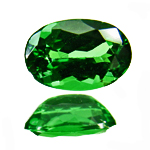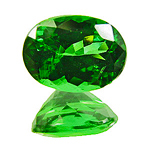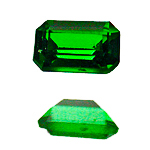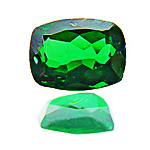Tsavolite/Tsavorite Garnet
A chrome-vanadium grossular. The most popular and commercially most important grossular variety.
Gemmologically correct it should be termed tsavolite but in the english-speaking parts of the world, the trade name tsavorite has taken hold.
Tsavorite shop
Origin of name: named in 1973 by Tiffany´s president Henry B. Platt and the discoverer of the gem, Scottish geologist Campbell R. Bridges, after the Tsavo National Park in Kenya, in the vicinity of which the most prolific deposits are located.
Can be confused with: emerald, green tourmaline (in particular with chrome-tourmaline) and demantoid garnet. Lighter coloured tsavolite may also be confused with peridot.
Localities: Kenya and Tanzania.




History: the first emerald green grossular garnets were found in the late 1960ies in the Lelatema Hills in Tanzania. Detailed studies found their colour to be due to traces of chromium.
In 1971 the Scottish geologist Campbell R. Bridges discovered another deposit south of the Teita Hills in Kenya. In 1973 other prospectors discovered a very prolific deposit, which became the Lualenyi Mine, in the vicinity of the town of Voi, Taita Taveta District, Coast Province, Kenya. The Kenyan stones were found to owe their colour to traces of vanadium, rather than traces of chromium like the Tanzanian tsavolites.
Campbell R. Bridges spent his life in Kenya and in 2009 was robbed and killed in his house in Voi.
Handling: somewhat sensitive to heat and acid, do not cover in borax. Brittle, set with care.
Worth knowing: tsavolites in general and stones of more than three carats in particular are extremely rare. Because of this and because of the unusual colour, tsavolite was regarded as an exotic kind of gemstone by the gems and jewellery community for decades. However, things started to change when goldsmiths, jewellers and gem lovers alike discovered the real virtues of tsavolite and increasingly use it as an alternative to emerald.
Indeed tsavolites have some major advantages over emeralds. Despite the slightly lower hardness, tsavolite definitely is a more carefree gem than emerald, which is hard but brittle and should be worn with care, particularly as a ringstone.
Moreover the average clarity of tsavolite is better than that of emerald and because of the higher refractive index it has a "harder" lustre, as well.
Then there is the rarity. In comparison with tsavolite, emerald is a commonplace gem.
And last but not least tsavolite, despite the rarity, is cheaper than emerald. Well, at least small stones are. Large tsavolites – and a five carat stone is already considered very large – of top quality come with a price tag that matches similarly sized fine emerald easily.
Tsavorite shop
 Deutsch
Deutsch